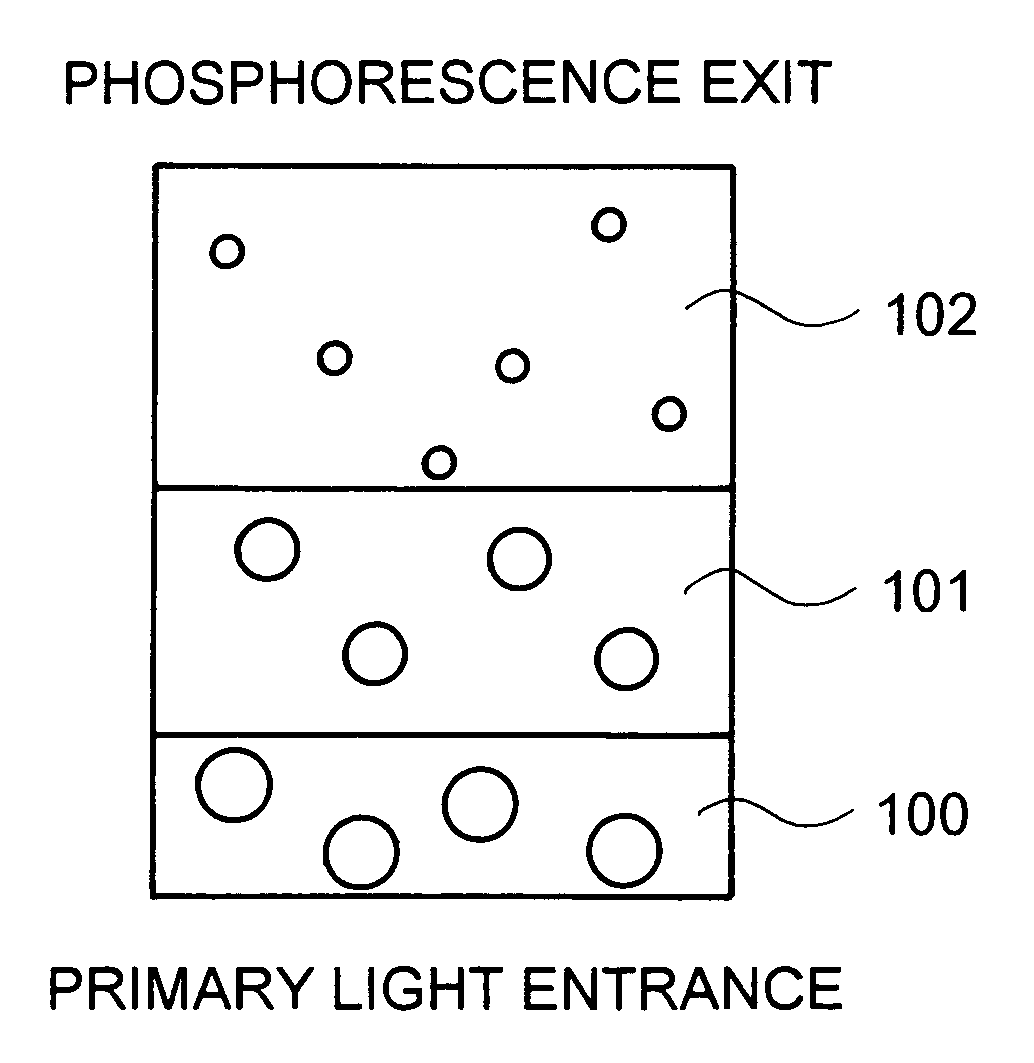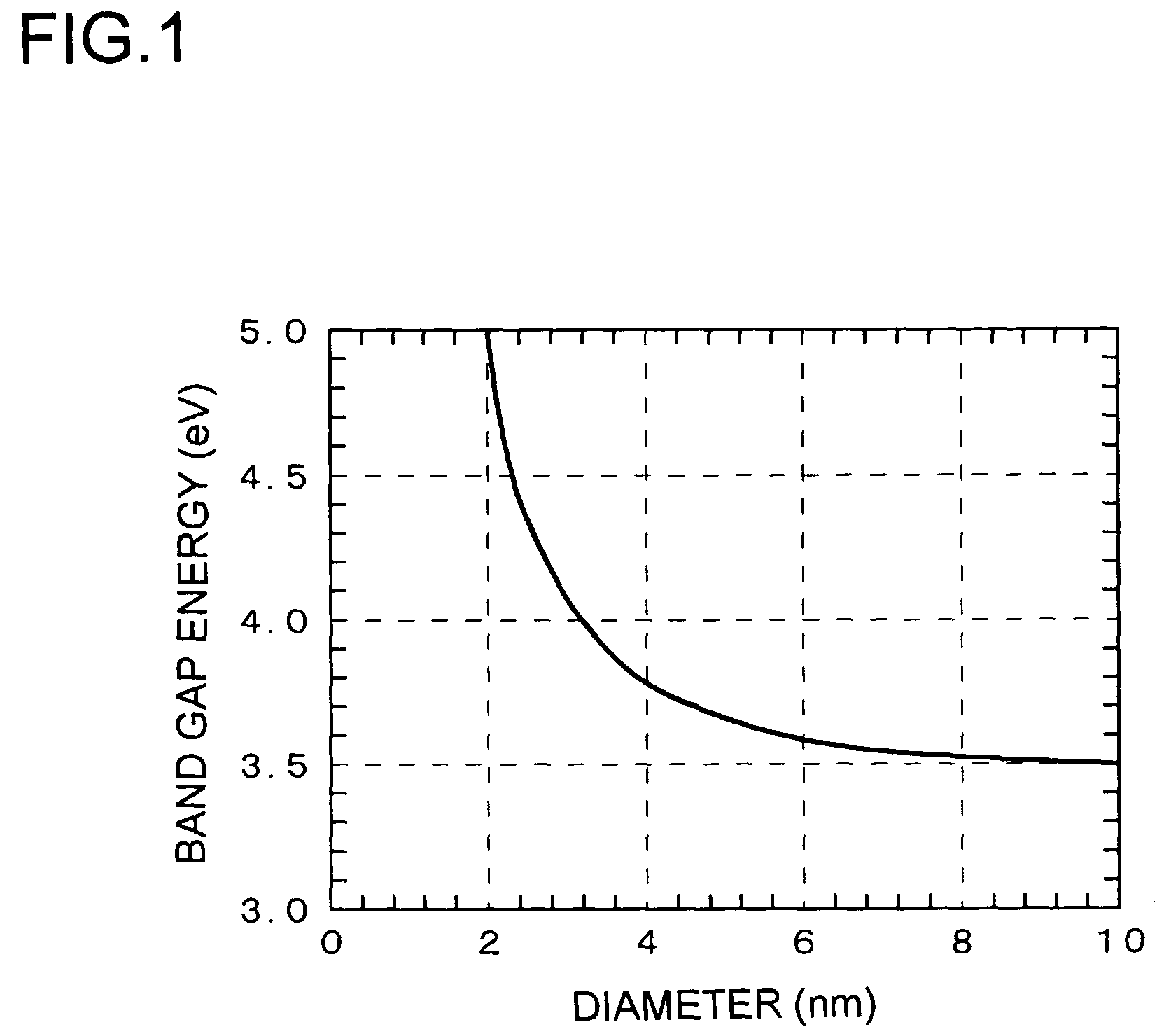Light-emitting apparatus, phosphor, and method of producing it
a technology of light-emitting apparatus and phosphor, which is applied in the direction of discharge tube/lamp details, semiconductor lasers, discharge tubes luminescnet screens, etc., can solve the problems of shortening the lifetime of excitation light sources, increasing power consumption, and difficulty in realizing light-emitting apparatuses. achieve the effect of high resolution and enhance the quantum efficiency of phosphor
- Summary
- Abstract
- Description
- Claims
- Application Information
AI Technical Summary
Benefits of technology
Problems solved by technology
Method used
Image
Examples
example 1
[0063]A light-emitting apparatus structured as shown in FIG. 3A was fabricated.
Primary Light Source
[0064]In this example, a stripe laser structured as shown in FIG. 8, i.e., one having a ridge structure, was fabricated as the primary light source. In the following description, the values given in cm−3 are carrier densities.
[0065]As shown in FIG. 8, on top of a GaN substrate 80, an n-GaN contact layer 81 (3 μm thick, 1×1018 cm−3), an n-Al0.1Ga0.9N clad layer 82 (1 μm thick, 1×1018 cm−), an n-GaN guide layer 83 (0.1 μm thick, 1×1018 cm−3), an In0.15Ga0.85N / In0.05Ga0.95N 3MQW active layer 84, a p-Al0.15Ga0.85N evaporation prevention layer 85 (0.02 μm thick, 1×1018 cm−3), a p-GaN guide layer 86 (0.1 μm thick, 1×1018 cm−3), a p-Al0.1Ga0.9N clad layer 87 (0.6 μm thick, 1×1018 cm−3), and a p-GaN contact layer 88 (0.1 μm thick, 1×1018 cm−3) were laid on one another.
[0066]Next, by RIE, this multilayer structure was partially etched from the top surface thereof so that the p-AlGaN clad l...
example 2
[0070]A light-emitting apparatus structured as shown in FIG. 3B was fabricated.
Primary Light Source
[0071]As the primary light source, the same laser as used in Example 1 was used.
[0072]InN nano-crystals having volumes of 3.375 nm3 to 64 nm3 (1.5 nm to 4 nm along each side) were grown by laser ablation, and then, on top of the InN, GaN was grown by laser ablation in a similar manner to produce InN / GaN nano-crystals having a quantum well structure as shown in FIG. 2. Then, acrylic resin having these nano-crystals dispersed therein was formed into a cylindrical shape. The reason that the volume varied from 3.375 nm3 to 64 nm3 (1.5 nm to 4 nm along each side) was that the volume that produced the same phosphorescence wavelength varied according to the conditions of growth.
Evaluation
[0073]When the laser of the above light-emitting apparatus was energized to cause laser oscillation, phosphorescence of a wavelength 520 nm was obtained with energy conversion efficiency of 120 [lm / W]...
example 3
[0075]A light-emitting apparatus structured as shown in FIG. 4 was fabricated.
Primary Light Source
[0076]In this example, an LED structured as shown in FIG. 10 was fabricated. In the following description, the values given in cm−3 are carrier densities.
[0077]As shown in FIG. 10, on top of a sapphire substrate 90, a buffer layer (not shown) was grown, and then an n-GaN contact layer 91 (3 μm thick, 1×1018 cm−3), an In0.12Ga0.87N / GaN 5MQW active layer 92, a p-Al0.15Ga0.85N evaporation prevention layer 93 (0.02 μm thick, 1×1018 cm−3), a p-GaN contact layer 94 (0.2 μm thick, 1×1018 cm−3), an laid on one another. Next, by RIE, this multilayer structure was partially etched from the top surface thereof so that the n-GaN contact layer 91 was exposed except for a portion thereof. Then, on top, an n-type electrode 95 (Ti / Al) was formed. Moreover, on top of the p-GaN contact layer 94, a p-type transparent electrode 96 (Pd; 0.008 nm) was formed, and on top of a portion thereof, a p-type el...
PUM
| Property | Measurement | Unit |
|---|---|---|
| Fraction | aaaaa | aaaaa |
| Fraction | aaaaa | aaaaa |
| Volume | aaaaa | aaaaa |
Abstract
Description
Claims
Application Information
 Login to View More
Login to View More - R&D
- Intellectual Property
- Life Sciences
- Materials
- Tech Scout
- Unparalleled Data Quality
- Higher Quality Content
- 60% Fewer Hallucinations
Browse by: Latest US Patents, China's latest patents, Technical Efficacy Thesaurus, Application Domain, Technology Topic, Popular Technical Reports.
© 2025 PatSnap. All rights reserved.Legal|Privacy policy|Modern Slavery Act Transparency Statement|Sitemap|About US| Contact US: help@patsnap.com



